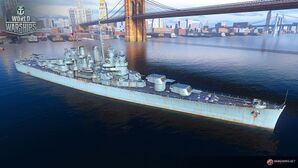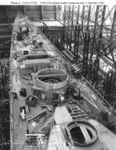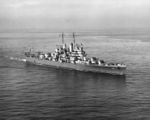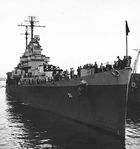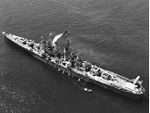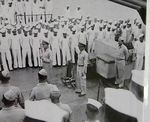| Revision as of 23:59, 13 August 2016 Removed unnecessary official screenshot provided from gallery | | Revision as of 07:56, 14 August 2016 Corrected error in coding of gallery sections; both correctly display now. Cleaned up wording of pros/cons. |
| Line 5: | | Line 5: |
| | | | | |
| | |Performance=<!-- write text about performance in battles below --> | | | |Performance=<!-- write text about performance in battles below --> |
| | | + | |
| | The Cleveland is a very solid tier 6 cruiser due to its high rate of fire, excellent AA, good maneuverability and speed, and reliable armor compared to its tier 6 cruiser counterparts. While the Cleveland may have abominably slow shells at 11km to max range, it has a great rate of fire that allows it quickly put down enemy cruisers and destroyers within its reach. Additionally, the slow AP shells at long range can still reliably penetrate the citadels of other lightly armored cruisers when they are broadside, such as the Aoba and Nurnberg. Furthermore, due to its high shell arc, it can easily shoot from behind islands safely as well as shoot at enemy ships hiding behind islands, rendering the enemy's cover useless. But because of its shell arc and long flight time, it is highly recommended to zoom out when firing at speedy and nimble ships. It is also highly recommended to not fire at destroyers more than 12km even when fully zoomed out, again due to the shell flight time. In summary, while the Cleveland has horrendously slow shells, it is, overall, a great tier 6 cruiser. | | | The Cleveland is a very solid tier 6 cruiser due to its high rate of fire, excellent AA, good maneuverability and speed, and reliable armor compared to its tier 6 cruiser counterparts. While the Cleveland may have abominably slow shells at 11km to max range, it has a great rate of fire that allows it quickly put down enemy cruisers and destroyers within its reach. Additionally, the slow AP shells at long range can still reliably penetrate the citadels of other lightly armored cruisers when they are broadside, such as the Aoba and Nurnberg. Furthermore, due to its high shell arc, it can easily shoot from behind islands safely as well as shoot at enemy ships hiding behind islands, rendering the enemy's cover useless. But because of its shell arc and long flight time, it is highly recommended to zoom out when firing at speedy and nimble ships. It is also highly recommended to not fire at destroyers more than 12km even when fully zoomed out, again due to the shell flight time. In summary, while the Cleveland has horrendously slow shells, it is, overall, a great tier 6 cruiser. |
| | | + | |
| | |Research=<!-- write text about priority sequence of research below --> | | | |Research=<!-- write text about priority sequence of research below --> |
| | | + | |
| | Quickly research and upgrade to the Mk6 mod 2 FCS module, as it is quite lame to have range comparable to the Furutaka. And then simply quickly get the 2nd hull and upgrade the 152mm guns for better rate of fire. While the turrets become slower, it is much more valuable to have the extra 1.5 RPM. | | | Quickly research and upgrade to the Mk6 mod 2 FCS module, as it is quite lame to have range comparable to the Furutaka. And then simply quickly get the 2nd hull and upgrade the 152mm guns for better rate of fire. While the turrets become slower, it is much more valuable to have the extra 1.5 RPM. |
| | | + | |
| | |Pros=<!-- write list of positive points below. use * as in ordinary wiki-list. --> | | | |Pros=<!-- write list of positive points below. use * as in ordinary wiki-list. --> |
| ? | *Citadel armor can easily withstand calibers 155mm and below when broadside | | + | |
| ? | *reliable armor | | + | *Citadel armor can easily withstand calibers 155mm and below when broadside. |
| ? | *Excellent AA suite | | + | *Reliable armor. |
| ? | *good rate of fire | | + | *Excellent AA suite. |
| ? | *Good shell arcs for shooting over islands | | + | *Good rate of fire. |
| ? | *Decent fire chance which can be upgraded to be comparable to that of IJN cruisers (15%) | | + | *Good shell arcs for shooting over islands. |
| ? | *Decent maneuverability | | + | *Decent fire chance which can be upgraded to be comparable to that of Japanese cruisers (15%). |
| | | + | *Decent maneuverability. |
| | | + | |
| | |Cons=<!-- write list of negative points below. use * as in ordinary wiki-list. --> | | | |Cons=<!-- write list of negative points below. use * as in ordinary wiki-list. --> |
| ? | *Large profile (high detection) | | + | |
| ? | *long shell air time, beading fast ships will be hard | | + | *Large profile (high detection). |
| ? | *fairly easy to catch on fire | | + | *Long shell hang time, leading fast ships is challenging at the edge of her range. |
| ? | *AA guns easily knocked out | | + | *Fairly easy to catch on fire. |
| ? | *turrets are fairly easy to destroy | | + | *AA guns easily knocked out. |
| ? | |Gallery=<!-- write below list of files without tags. description (if necessary) for each should be separated with template {{!}} --><gallery> | | + | *Turrets are vulnerable to higher-caliber armor piercing rounds. |
| ? | File:Carousel USS Cleveland.jpg|Official WoWS model of the ''Cleveland'' | | + | |
| ? | File:Cleveland1 верс 0 4 0 110854.jpeg|Broadside view of the ''Cleveland'' | | + | |Gallery=<!-- write below list of files without tags. description (if necessary) for each should be separated with template {{!}} --> |
| ? | File:Cleveland 2 верс 0 4 0 110854.jpeg|Rear view of the ''Cleveland'' | | + | |
| ? | </gallery>|History=<!-- write text below --> | | + | File:Carousel USS Cleveland.jpg{{!}}Official WoWS model of the ''Cleveland'' |
| ? | As the second ship to be named after Cleveland, Ohio, the USS ''Cleveland'' (CL-55) was the lead ship of the series of 27 ''Cleveland''-class light cruisers. Commissioned in 1942, it saw extensive service in the Pacific and Mediterranean theaters. The class was designed as an improved and slightly larger version of the ''Brooklyn''-class light cruisers, with the intention of having better cruising range, anti-aircraft defense, etc. compared with earlier US light cruisers. In order to save time and money, they were built using armament that was already proven. Packing strong Anti-air and anti-ship firepower, decent armor, and good speed, the ''Cleveland'' cruisers proved to be excellent light cruisers, serving the US Navy well into the 1970's. Of the 52 originally planned ships, nine were completed as ''Independence''-class carriers and two as the ''Fargo''-class cruisers. What separated the ''Fargo''-class from the ''Cleveland''-class were their distinctly more compact superstructure with a single funnel and improved anti-aircraft armament arcs. Of the 13 designed and planned ''Fargo''-class cruisers, only the ''Fargo'' and ''Huntington'' were completed. By 1950, all ''Cleveland''-class cruisers were decommissioned and eventually sold for scrap.<br /> | | + | File:Cleveland1 верс 0 4 0 110854.jpeg{{!}}Broadside view of the ''Cleveland'' |
| ? | <br /> | | + | File:Cleveland 2 верс 0 4 0 110854.jpeg{{!}}Rear view of the ''Cleveland'' |
| ? | Joining Task Force 18, the USS ''Cleveland'' first saw action at the Solomon Islands - its first mission was to guard a troop convoy. The ship would provide artillery bombardment in many of the invasions and anti-air defense, as well as covering fire and softening-up bombardments. One such notable event was during the invasion of Tinian, when captain Andrew Shepard ordered the crew to maneuver the ship between the USS ''Norman Scott'' (DD-690) and the main shore batteries, preventing the enemy from being able to fire at the ''Norman Scott''. The destroyer was drawing fire away from the USS ''Colorado'', only to be hit directly six times by main shore batteries. Its captain Seymour Owens and 22 others were killed, leaving the destroyer very vulnerable. Captain Shepard's quick thinking and his crew managed to save the many lives of the ''Norman Scott'' during that battle.<br /> | | + | |
| ? | <br /> | | + | |History=<!-- write text below --> |
| ? | Over the next five years, the ''Cleveland'' would be captained by four other officers until February 1947, when it was decommissioned and put into reserve in Philadelphia, Pennsylvania. At the end of the war, the USS ''Cleveland'' received 13 battle stars for its service. Astonishingly, all ''Cleveland''-class cruisers survived to the end of war and were decommissioned in 1950, save for the ''Manchester'', never to see service again. However, six of the decommissioned cruisers were later converted into the ''Providence'' and ''Galveston''-class guided missile cruisers. Because of stability problems due to the topweight of the missile systems, the ''Providence'' and ''Galveston''-class cruisers were decommissioned to the reserve fleet between 1969 and 1974 and 1970 and 1979, respectively. The last remaining ''Cleveland''-class is the USS ''Little Rock Galveston''-class guided missile cruiser, which now resides as a museum ship in Buffalo, New York. | | + | As the second ship to be named after Cleveland, Ohio, the USS ''Cleveland'' (CL-55) was the lead ship of the series of 27 ''Cleveland''-class light cruisers. Commissioned in 1942, it saw extensive service in the Pacific and Mediterranean theaters. The class was designed as an improved and slightly larger version of the ''Brooklyn''-class light cruisers, with the intention of having better cruising range, anti-aircraft defense, etc. compared with earlier US light cruisers. In order to save time and money, they were built using armament that was already proven. Packing strong Anti-air and anti-ship firepower, decent armor, and good speed, the ''Cleveland'' cruisers proved to be excellent light cruisers, serving the US Navy well into the 1970's. Of the 52 originally planned ships, nine were completed as ''Independence''-class carriers and two as the ''Fargo''-class cruisers. What separated the ''Fargo''-class from the ''Cleveland''-class were their distinctly more compact superstructure with a single funnel and improved anti-aircraft armament arcs. Of the 13 designed and planned ''Fargo''-class cruisers, only the ''Fargo'' and ''Huntington'' were completed. By 1950, all ''Cleveland''-class cruisers were decommissioned and eventually sold for scrap. |
| ? | |HistoricalGallery=<!-- write below list of files without tags. description (if necessary) for each should be separated with template {{!}} --><gallery> | | + | |
| | | + | Joining Task Force 18, the USS ''Cleveland'' first saw action at the Solomon Islands - its first mission was to guard a troop convoy. The ship would provide artillery bombardment in many of the invasions and anti-air defense, as well as covering fire and softening-up bombardments. One such notable event was during the invasion of Tinian, when captain Andrew Shepard ordered the crew to maneuver the ship between the USS ''Norman Scott'' (DD-690) and the main shore batteries, preventing the enemy from being able to fire at the ''Norman Scott''. The destroyer was drawing fire away from the USS ''Colorado'', only to be hit directly six times by main shore batteries. Its captain Seymour Owens and 22 others were killed, leaving the destroyer very vulnerable. Captain Shepard's quick thinking and his crew managed to save the many lives of the ''Norman Scott'' during that battle. |
| | | + | |
| | | + | Over the next five years, the ''Cleveland'' would be captained by four other officers until February 1947, when it was decommissioned and put into reserve in Philadelphia, Pennsylvania. At the end of the war, the USS ''Cleveland'' received 13 battle stars for its service. Astonishingly, all ''Cleveland''-class cruisers survived to the end of war and were decommissioned in 1950, save for the ''Manchester'', never to see service again. However, six of the decommissioned cruisers were later converted into the ''Providence'' and ''Galveston''-class guided missile cruisers. Because of stability problems due to the topweight of the missile systems, the ''Providence'' and ''Galveston''-class cruisers were decommissioned to the reserve fleet between 1969 and 1974 and 1970 and 1979, respectively. The last remaining ''Cleveland''-class is the USS ''Little Rock'', a ''Galveston''-class guided missile cruiser, which now resides as a museum ship in Buffalo, New York. |
| | | + | |
| | | + | |HistoricalGallery=<!-- write below list of files without tags. description (if necessary) for each should be separated with template {{!}} --> |
| | | + | <gallery> |
| | File:USS Cleveland (CL-55) 1941.jpg|Under construction, 1 October 1941 | | | File:USS Cleveland (CL-55) 1941.jpg|Under construction, 1 October 1941 |
| | File:USS Cleveland (1941).jpg|USS ''Cleveland'' at sea in 1942 | | | File:USS Cleveland (1941).jpg|USS ''Cleveland'' at sea in 1942 |
| Line 39: | | Line 51: |
| | File:USS Cleveland (CL-55) 1945 capt.jpg|Captain Hopwood bids farewell to the crew | | | File:USS Cleveland (CL-55) 1945 capt.jpg|Captain Hopwood bids farewell to the crew |
| | File:Cleveland-class cruiser technical drawing.png|Technical drawing of a ''Cleveland''-class cruiser. | | | File:Cleveland-class cruiser technical drawing.png|Technical drawing of a ''Cleveland''-class cruiser. |
| ? | </gallery>|Video=<!-- put below video clips with using template VideoYT. You can use html-tags for formatting. --> | | + | </gallery> |
| | | + | |Video=<!-- put below video clips with using template VideoYT. You can use html-tags for formatting. --> |
| | | | | |
| | |Ref= <!-- write below --> | | | |Ref= <!-- write below --> |
| ? | *Wikipedia | | + | |
| ? | *okieboat.com | | + | * okieboat.com |
| ? | *Volume I: U.S. Navy, U.S. Marine Corps and U.S. Coast Guard Aircraft Lost ... | | + | * Wikipedia |
| ? | *USS Cleveland CL-55 Reunion Association | | + | * Volume I: U.S. Navy, U.S. Marine Corps and U.S. Coast Guard Aircraft Lost ... |
| ? | *The Best Light Cruisers of World War II | | + | * USS Cleveland CL-55 Reunion Association |
| ? | *Navysite | | + | * The Best Light Cruisers of World War II |
| | | + | * Navysite |
| | }}<!-- DO NOT DELETE THIS LINE. DO NOT INSERT ANYTHING BELOW THIS LINE --> | | | }}<!-- DO NOT DELETE THIS LINE. DO NOT INSERT ANYTHING BELOW THIS LINE --> |
The Cleveland is a very solid tier 6 cruiser due to its high rate of fire, excellent AA, good maneuverability and speed, and reliable armor compared to its tier 6 cruiser counterparts. While the Cleveland may have abominably slow shells at 11km to max range, it has a great rate of fire that allows it quickly put down enemy cruisers and destroyers within its reach. Additionally, the slow AP shells at long range can still reliably penetrate the citadels of other lightly armored cruisers when they are broadside, such as the Aoba and Nurnberg. Furthermore, due to its high shell arc, it can easily shoot from behind islands safely as well as shoot at enemy ships hiding behind islands, rendering the enemy's cover useless. But because of its shell arc and long flight time, it is highly recommended to zoom out when firing at speedy and nimble ships. It is also highly recommended to not fire at destroyers more than 12km even when fully zoomed out, again due to the shell flight time. In summary, while the Cleveland has horrendously slow shells, it is, overall, a great tier 6 cruiser.
Quickly research and upgrade to the Mk6 mod 2 FCS module, as it is quite lame to have range comparable to the Furutaka. And then simply quickly get the 2nd hull and upgrade the 152mm guns for better rate of fire. While the turrets become slower, it is much more valuable to have the extra 1.5 RPM.
